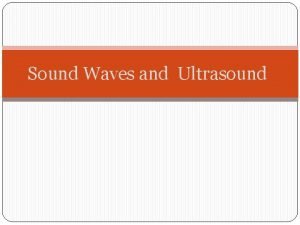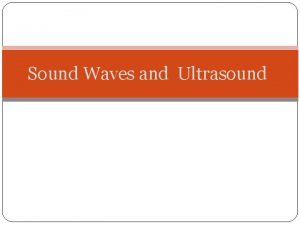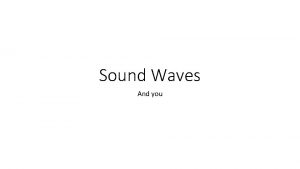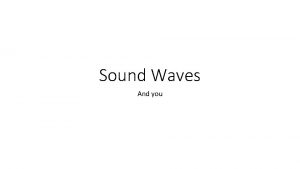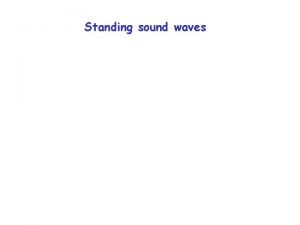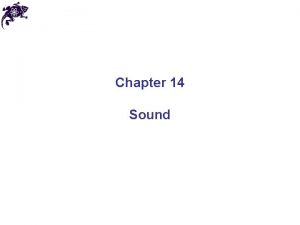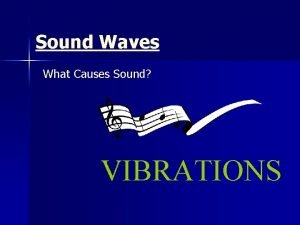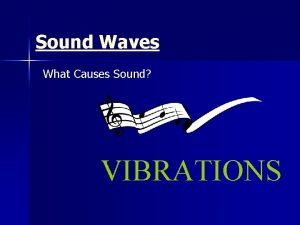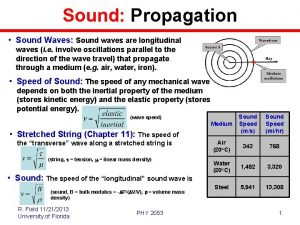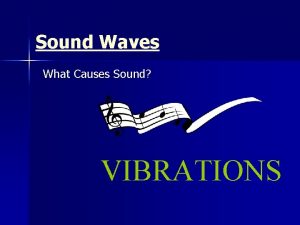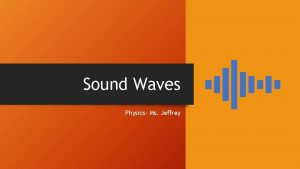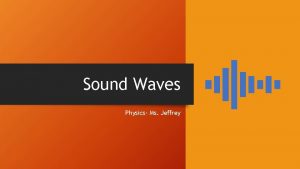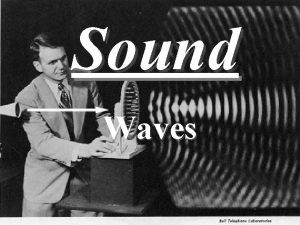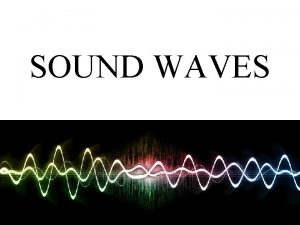The Science of Sound Sound waves Sound waves



































- Slides: 35

The Science of Sound

Sound waves � Sound waves are longitudinal waves. Longitudinal waves comprise of a series of compressions and expansions ( rarefactions).

� Sound waves require a state of matter to travel through. � Sound can travel through solids, liquids or gases( air).

� The particles in the state of matter vibrate and carry the sound wave. � The particle vibrate in the same direction as the wave is travelling

� Sound waves are said to have a ‘bulk effect’, that means that the sound wave travels in all directions from the source.

� If no medium( state of matter) is present the compression and rarefaction of the particles cannot be formed, hence no sound wave is produced.

� Sound waves cannot travel with out a state of matter. � Therefore sound cannot travel in Vacuum. �A Vacuum is a space where there is no matter.

� Can you think of a place where there is no matter, not even air? � Outer Space !

� http: //phet. colorado. edu/en/simulation/sou nd

Reception of sound

Reception of sound � For sound to be heard, it must first go through a sequence of steps. � 1) The sound wave must meet the ear drum � 2) The eardrum vibrates at the same frequency of the sound wave. � 3) The vibrations are passed from the ear drum to 3 tiny bones in the ear (Stapes, Malleus, Incus).

� 4) The vibrations are passed onto the middle ear and then to the inner ear. � 5) In the inner ear the vibrations are converted to electrical signals � 6) These electrical signal are then taken to the brain. � 7) In the brain these electrical signals are interpreted by the brain as sound.


Activity � Question � Astronauts on the moon cannot speak to each other as they might do on earth. Explain why? � Suggest how they may communicate with each other?

Speed of sound � Sound travels at a speed of 330 m/s( in air) � Mean while light travels at a speed of 300 000 m/s � Sound � This travel substantially slower than light. is why we see things at a distance before we hear them.

� Examples � Timing a race: - This is why we start the clock as we see the flash from the gun and not when we hear the sound of the gun being fired, when timing a race from the finish line.

� Lightning and thunder: - This is why we see the lightening before we hear the rumble of the thunder.

Properties of Sound Waves � Like all waves. � Sound waves can be � Reflected � Refracted � Diffracted � Super-imposed

Reflection of Sound � Sound waves obey the Law of reflection. � i=r � The law of reflection states that the angle of the incidence is equal to the angle of reflection.

� The speed of sound varies, depending on the state of matter, the sound wave is travelling through. � Sound travels faster in liquids than in gases; � And travel even faster in solids than in liquids.

� Echoes are the most familiar example of reflection of sound.

Refraction of sound � It is easier to hear at night than during the day. This is because sound travels at different speeds at different temperatures.

Pitch � The pitch of a note is related to the frequency of the note. � The frequency of a wave, is the number of wave cycles that are produced every second.

� Soprano singers have a high pitch ( high frequency) � Bass singer have a low pitch ( low frequency)

Loudness � The loudness of a sound is associated with the amplitude of the sound. � The amplitude of a wave is the maximum displacement of the wave from the rest position.

� The greater the amplitude, the louder the sound. � The smaller the amplitude, the quieter the sound.

The audible range � Human hear sound which have a frequency in the range between 20 Hz – 20 k. Hz ( therefore threshold of hearing is 1000 Hz).

� Subsonic sounds have frequencies below 20 Hz these cannot be heard by humans, but can be heard by elephants. � Earth tremors have frequencies in this range this is why they can be felt, and not heard.

� Ultra sounds have frequencies greater that 20 k. Hz. � Again this frequency cannot be heard by humans; but can be heard by bats, bats use ultrasound to help them navigate in the dark.

� Also dogs hear at these high frequencies. � Most dog whistles produce sound within the range of 23 - 54 KHz (ultrasound).

Audible hearing range

Activity � Using your text books give 3 uses of ultrasound. `



END � Answer the assessment questions to see how much you have learnt.
 Electromagnetic waves are transverse waves true or false
Electromagnetic waves are transverse waves true or false Transfer of energy when a wave disappears into a surface
Transfer of energy when a wave disappears into a surface The wave chapter 13
The wave chapter 13 Sound waves longitudinal waves
Sound waves longitudinal waves Properties of waves
Properties of waves Talk about your favorite subject
Talk about your favorite subject Transverse waves move perpendicular
Transverse waves move perpendicular Mechanical waves examples
Mechanical waves examples Short wave vs long wave radiation
Short wave vs long wave radiation Difference between matter waves and electromagnetic waves
Difference between matter waves and electromagnetic waves Mechanical vs electromagnetic
Mechanical vs electromagnetic Mechanical waves and electromagnetic waves similarities
Mechanical waves and electromagnetic waves similarities Seismic waves
Seismic waves Seismic waves are mechanical waves
Seismic waves are mechanical waves Compare and contrast p waves and s waves using venn diagram
Compare and contrast p waves and s waves using venn diagram Venn diagram of mechanical and electromagnetic waves
Venn diagram of mechanical and electromagnetic waves Differences between constructive and destructive waves
Differences between constructive and destructive waves Hát kết hợp bộ gõ cơ thể
Hát kết hợp bộ gõ cơ thể Lp html
Lp html Bổ thể
Bổ thể Tỉ lệ cơ thể trẻ em
Tỉ lệ cơ thể trẻ em Gấu đi như thế nào
Gấu đi như thế nào Glasgow thang điểm
Glasgow thang điểm Hát lên người ơi alleluia
Hát lên người ơi alleluia Môn thể thao bắt đầu bằng từ chạy
Môn thể thao bắt đầu bằng từ chạy Thế nào là hệ số cao nhất
Thế nào là hệ số cao nhất Các châu lục và đại dương trên thế giới
Các châu lục và đại dương trên thế giới Cong thức tính động năng
Cong thức tính động năng Trời xanh đây là của chúng ta thể thơ
Trời xanh đây là của chúng ta thể thơ Cách giải mật thư tọa độ
Cách giải mật thư tọa độ 101012 bằng
101012 bằng độ dài liên kết
độ dài liên kết Các châu lục và đại dương trên thế giới
Các châu lục và đại dương trên thế giới Thể thơ truyền thống
Thể thơ truyền thống Quá trình desamine hóa có thể tạo ra
Quá trình desamine hóa có thể tạo ra Một số thể thơ truyền thống
Một số thể thơ truyền thống





































